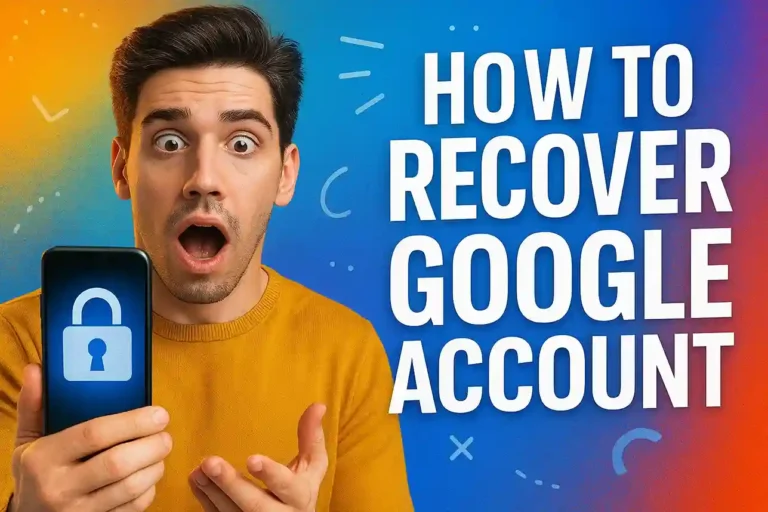Recover Gmail Account: get back your inbox
Lost access to your Gmail can feel overwhelming, but learning to recover Gmail account is simpler than expected.
Discover proven methods that restore your email access quickly through official Google recovery systems and backup options.
Start implementing these step-by-step solutions today and regain control of your important messages and digital life.
Understanding Gmail Account Recovery Options
Google provides multiple pathways to help users regain access when they need to recover gmail account access after lockouts or forgotten credentials.
The gmail recovery steps involve verification through phone numbers, backup emails, security questions, or trusted device authentication methods.
These recovery mechanisms work together to ensure legitimate account owners can restore access while maintaining security against unauthorized attempts.
Common Reasons for Gmail Account Access Issues
Forgotten gmail login credentials represent the most frequent cause of account access problems, especially after extended periods of automatic sign-in.
Suspicious activity detection can trigger automatic account locks, requiring users to reset google credentials through verification processes before regaining access.
Lost gmail email situations also occur when users change phone numbers, lose backup email access, or forget security question answers completely.
Password-Related Problems
Users often create complex passwords that become difficult to remember, leading to multiple failed login attempts and temporary account restrictions.
Browser password managers sometimes store outdated credentials, creating confusion when actual passwords have been changed through other devices or locations.
Password reset emails may go unnoticed in spam folders or secondary email accounts, delaying the recovery process significantly.
Security Verification Issues
Two-factor authentication can backfire when users lose access to their registered phone numbers or authentication apps during device changes.
Gmail recovery number updates often get overlooked, leaving users with outdated contact information when emergency access becomes necessary for account restoration.
Security questions become problematic when answers were created years ago with information that users no longer remember accurately or completely.
Step-by-Step Gmail Account Recovery Process
Begin the recovery process by visiting the official Google Account Recovery page and entering your email address or phone number carefully.
Select the appropriate recovery method when prompted, choosing from available options like phone verification, gmail recovery email, or security questions based on setup.
Follow verification instructions precisely, entering codes or answering questions exactly as they appear to avoid triggering additional security measures during recovery.
Phone Number Recovery Method
The recover gmail via phone option sends verification codes through SMS or voice calls to your registered mobile device number.
Enter the six-digit code within the specified time limit, typically five minutes, to proceed with the password reset process successfully.
Choose a strong new password that combines letters, numbers, and symbols while avoiding previously used passwords for enhanced security moving forward.
Recovery Email Verification
Check your designated backup email account for recovery messages from Google, including spam and promotional folders for complete coverage.
Click the verification link within the recovery email promptly, as these links expire after specific time periods for security purposes.
Complete the password reset process by creating new credentials that meet Google’s current security requirements and complexity standards effectively.
Advanced Recovery Techniques
When standard methods fail, users can access gmail after reset by providing detailed account history information to Google’s recovery specialists.
The account recovery form requests specific details like creation dates, frequently contacted emails, recent password changes, and device information for verification.
This manual review process typically takes 3-5 business days, requiring patience while Google security teams validate the provided information thoroughly.
Account History Verification
Google may request information about recent emails sent, contacts frequently messaged, or specific folders and labels created within your account.
Previous passwords, even if partially remembered, can help verify identity when combined with other account details and usage patterns.
Device information, including computers and phones previously used to access the account, strengthens verification during the manual review process.
Required Documentation
Prepare answers about account creation circumstances, including approximate dates, locations, and devices used for initial setup when possible.
List recent significant emails or attachments that demonstrate ongoing account usage and familiarity with account contents and activities.
Provide alternative contact information where Google can reach you during the verification process for additional questions or status updates.
Recovering Suspended or Disabled Accounts
To recover suspended gmail accounts, users must first understand the specific violation that triggered the suspension through Google’s notification systems.
Policy violations like spam sending, suspicious activity, or terms of service breaches require different approaches for successful account restoration efforts.
The appeals process involves submitting detailed explanations and evidence to demonstrate legitimate account usage and commitment to policy compliance moving forward.
Understanding Suspension Reasons
Common suspension triggers include automated spam detection, unusual login patterns, or reports from other users about suspicious account behavior patterns.
Review Google’s email policies thoroughly to identify potential violations and prepare appropriate responses that address specific concerns raised during suspension.
Document legitimate usage patterns and gather evidence that contradicts automated detection systems that may have incorrectly flagged normal activities.
The main steps for suspension appeals include:
- Submit detailed appeals through official Google forms
- Provide evidence of legitimate account usage
- Explain circumstances that led to policy violations
- Demonstrate understanding of Google’s terms of service
Preventing Future Account Access Issues
Proactive account security measures help users avoid situations where they need to retrieve google login info through complex recovery processes.
Regular updates to recovery information, including phone numbers and backup emails, ensure multiple access routes remain available during emergency situations.
Security settings reviews every few months help maintain current contact information and verify that recovery methods remain accessible and functional.
Setting Up Multiple Recovery Options
Configure both phone and email recovery methods to create redundant access paths that work even when one method becomes unavailable.
Enable two-factor authentication with backup codes stored securely offline, providing access even when primary authentication devices are lost or damaged.
Consider using Google’s Advanced Protection Program for high-security needs, though this requires physical security keys for enhanced account protection.
Essential security practices include:
- Update recovery phone numbers immediately after changes
- Maintain access to backup email accounts
- Store security codes in secure, offline locations
- Review account activity regularly for suspicious patterns
- Use unique, strong passwords for Google accounts
Professional Recovery Services and Alternatives
When standard recovery methods fail, users seeking google recovery help can explore professional services that specialize in account restoration.
However, legitimate recovery services work within Google’s official systems and cannot bypass security measures that protect against unauthorized access attempts.
Be cautious of services promising guaranteed recovery, as these often represent scams that cannot deliver on unrealistic promises about account restoration.
Legitimate Recovery Assistance
Google Workspace administrators can assist with business account recovery through enterprise-level support channels and administrative override capabilities.
Certified Google Partners may offer guidance on complex recovery situations, though they cannot override security measures or expedite manual review processes.
Legal professionals can help in extreme cases involving identity theft or unauthorized account changes that require law enforcement involvement.
Warning Signs of Recovery Scams
Avoid services requesting upfront payments or promising guaranteed results, as legitimate assistance works within Google’s free recovery system framework.
Never provide existing passwords or personal information to third-party recovery services, as this creates additional security risks and potential violations.
Legitimate services focus on guidance and documentation assistance rather than claiming direct access to Google’s internal recovery systems.
Mobile App Recovery and Access
Users can access blocked gmail through mobile apps by clearing app data and re-authenticating with recovered credentials or alternative sign-in methods.
The Gmail mobile app often maintains cached credentials that may work even when web access fails, providing alternative entry points during recovery.
Mobile device recovery involves removing and reinstalling the Gmail app, then signing in with newly recovered account credentials for fresh authentication.
Troubleshooting Mobile Access Issues
Clear Gmail app cache and stored data through device settings to eliminate corrupted authentication information that prevents successful login attempts.
Update the Gmail app to the latest version, as older versions may have compatibility issues with current Google security protocols.
Try signing in through different networks, as some corporate or public WiFi systems block or interfere with Google authentication processes.
Common mobile troubleshooting steps include:
- Force-stop and restart the Gmail application
- Clear application cache and stored data
- Update to the latest app version available
- Try different internet connections or networks
When Recovery Attempts Fail
If all recovery methods fail, users must focus on finding google credentials through alternative methods like checking saved passwords in browsers.
Browser password managers, including Chrome, Firefox, and Safari, may contain saved Gmail credentials that users forgot they had stored previously.
Written password records, though not recommended for security, might exist in personal documents or notes that could provide access information.
Creating New Accounts
When recovery proves impossible, creating a new Gmail account becomes necessary, though this means losing access to previous emails and contacts permanently.
Inform important contacts about the new email address immediately to maintain communication and update account information with essential services and subscriptions.
Consider how to fix gmail issues that led to the original problem to prevent similar situations with the new account setup.
Data Recovery Considerations
Important emails may exist in other email clients or mobile devices that downloaded messages before account access was lost completely.
Contacts might be recoverable through phone synchronization or other Google services if they were previously synced across multiple devices.
Essential documents attached to emails may exist in downloads folders or cloud storage services where they were previously saved.
Advanced Security After Recovery
After successful recovery, users should immediately review account security settings to unlock gmail account protection against future unauthorized access attempts.
Change passwords, update recovery information, and review connected applications that have access to the Gmail account for enhanced security moving forward.
Enable additional security features like login alerts and device verification to monitor account access and detect suspicious activity quickly.
Security Settings Optimization
Review and remove outdated recovery information, including old phone numbers and inactive email addresses that could become security vulnerabilities.
Audit connected applications and revoke access for unused services or apps that no longer require Gmail integration for functionality.
Set up security alerts for login attempts from new devices or locations to maintain awareness of account access patterns.
Critical post-recovery security steps include:
- Change account passwords immediately after recovery
- Update all recovery contact information
- Review and clean up connected applications
- Enable enhanced security notifications
- Document new security settings securely
Conclusion
Successfully learning to recover gmail account access requires understanding Google’s multi-layered security system and available recovery methods.
Prevention through proper security setup and regular information updates proves more effective than dealing with emergency recovery situations later.
With proper preparation and knowledge of recovery processes, users can maintain reliable access to their Gmail accounts and digital communications.
Frequently Asked Questions
How long does Gmail account recovery typically take?
Standard recovery methods work immediately, while manual review processes typically require 3-5 business days for completion and response.
Can I recover my Gmail account without phone access?
Yes, recovery email, security questions, or manual review processes can restore access when phone verification isn’t available or functional.
What information does Google need for manual account recovery?
Google requests account creation details, recent passwords, frequently contacted emails, and device information used to access the account previously.
Are third-party Gmail recovery services legitimate?
Most legitimate services only provide guidance within Google’s official systems; avoid services promising guaranteed results or requesting payments upfront.
How can I prevent future Gmail account access issues?
Maintain current recovery information, use strong unique passwords, enable two-factor authentication, and regularly review security settings for optimal protection.






